BY THE MID-1950S MOVING OUT OF THE CITY TO A HOUSE with a grassy lawn and a two-car garage had become part of the American Dream. With excellent trains running from Grand Central Station and Penn Station in Manhattan and newfound prosperity making cars more affordable, suddenly the residents of Brooklyn were eyeing fresh places to live, not only on the newly subdivided farms and potato fields of Long Island but in the suburbs of Westchester, Connecticut, and New Jersey as well. Arthur Levitt had built a huge community of single-family houses at affordable prices on Long Island. The Brooklyn apartments were aging. Children were going off to college and leaving the nest. This was not white flight. Whites were not fleeing from anything—yet. That would come later. Rather, people were beginning to migrate out of Brooklyn because they were seeking to escape the city’s heat and concrete, to own their own lawns and backyards, to get their slice of the American Dream. Also, there was money to be made in the suburbs. The story of Henry Grad is typical of a Brooklynite who left for the greener pastures of the suburbs.
Henry Grad’s father, Isaac, left Russia before the turn of the twentieth century, but only made it as far as England. The family name wasn’t always Grad, however. As the story goes, it was either Stivian or Simeonov. When Isaac, who worked in the fur business in Moscow, went to work in the countryside either as a trapper or skinner, his rural coworkers nicknamed him “Townie.” The Old Russian word for “Townie”—or “city”—is “grad” (think of Leningrad, Stalingrad). When he came to London, Grad was the name he adopted. He had four children with his first wife, who died. He remarried: a Latvian woman named Leah Salaway, and had five more children. Henry, born April 7, 1899, in Mile End Old Town—the East End slums—was the youngest of the nine. After World War I, where he spent time in the Royal Flying Corps and Royal Air Force as a wireless operator for the fifty-second Squadron in such places as Auxi-le-Château (near Amiens) and Escaudoeuvres (near Cambrai) in France, he joined the British merchant navy as a wireless operator. After sailing around the world, he came to Brooklyn to visit his sole American relative, his half-sister Millie from his father’s first marriage. Millie had married Austrian immigrant Louis Katz, who had five kids from his first wife, Dora Tannenbaum, who had since passed away, and four with his second wife, Millie. Living in the house with Henry’s half-sister Millie was Louis’s daughter Anna, from his first marriage. Millie was her stepmother. In 1921 Henry married Anna. His half-sister now also became his mother-in-law, and his brother-in-law also became his father-in-law!
During their courtship, Anna Katz told Henry she wanted to marry a professional man. He studied for two years at the Brooklyn College of Pharmacy. The job of a pharmacist, it turned out, required him to work sixteen hours a day, seven days a week. Had he stayed in the radio business, he’d have been far better off. In 1921, that was going to become a booming industry, especially with the advent of commercial broadcasting the following year.
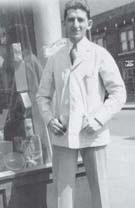
Henry Grad in front of his drugstore at the corner of Franklin and Union Streets, 1929. Courtesy of Ian Grad
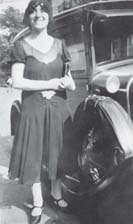
Anna Grad. Courtesy of Ian Grad
Instead, he opened a drugstore on the corner of Franklin Avenue and Union Street in Crown Heights. When the Depression hit, it went under. Unable to pay his bills or find work, he went back to Hendon, England, to live in his brother Jimmy’s house and work in his brother-in-law’s fur-dying business—a dirty, smelly job. Six months later his wife and six-year-old son Ian went to live with him. After seven months in England, Anna demanded they return to Brooklyn. Son Ian remembers.

Young Ian Grad checks out his tricycle in front of his father’s store, 1929. Courtesy of Ian Grad
IAN GRAD “My mother said, ‘We gotta go back to the States. I can’t stand it here.’ Because compared to the United States, living in England was like going back in time. They didn’t have central heating. They had fireplaces, and in the wintertime the house would be freezing. You’d have to warm up the sheets with hot coals before you got into bed. And she didn’t like living in someone else’s house, being second fiddle instead of being the lady of the house.
“So we came back to Brooklyn in October 1932 and rented a furnished room on Rochester Avenue, a few blocks from Eastern Parkway. My dad got a job with the New York City welfare department as a home investigator.
“My father wasn’t political. He hated the extremes on both sides. In the early 1930s you took whatever job you could get. He had to go around and visit the homes of the people on welfare to make sure they were doing what they were supposed to be doing to get free money from the city. He was paid $20 a week, and that’s a little hard to support a family, even at those days’ prices. My mother also got a job, as a bookkeeper, to make ends meet.
“After we moved to Crown Heights, around 1934 or 1935, my father began moonlighting as a pharmacist in addition to his city job, and as time went on, we became a little more affluent, because my mother began working as a trainer of insurance salesmen for a big insurance company. She also played the piano and violin and had a good singing voice, and she had taught music when I was little. Her mother, who died when she was young, had been a performer on the Yiddish stage in New York.
“We lived in an overall Jewish neighborhood. As a matter of fact, in the 1930s practically all of Brooklyn, it seemed, was Jewish. There were houses set up as synagogues and storefronts set up as synagogues, and regular buildings which were actually synagogues. As a kid, I didn’t pay much attention to religion. However, my parents, who were not very religious, decided that I should get a Jewish education, so they sent me to a yeshiva near my home, and I used to go there in the evenings, and there was a modern American woman teaching this stuff. The next year the class for my grade was going to be too late in the evening and my parents didn’t want me out at that hour, so they sent me a couple blocks down to a small synagogue run by a rabbi with a black hat and a long beard, and I took one look at him, and I said, ‘This is not where I come from.’ I didn’t relate to this old-fashioned stuff. That turned me off to the whole religious business.
“As I got older and started studying science, astronomy, and engineering, I said, ‘This whole business about a belief in God is a lot of hokum. There ain’t no such animal.’ I can remember years later riding on an airplane, and who sits next to me but a young Catholic priest, and he tried to start a conversation with me about religion, and I turned to him and said, ‘You know, you guys got it all wrong. God did not create man in his own image. It was the other way around. Man created God in his own image.’ And that was the end of the conversation. He left me alone after that.
“The Dodgers were an important part of our lives. I couldn’t afford to go to too many games. We didn’t have much money, but as a teenager I only lived three blocks from Ebbets Field on Montgomery Street between Nostrand and Rogers Avenues. You walked straight down the block and got right to Ebbets Field. When I went to the games, I would pay $1.65 and sit in the grandstand and watch a doubleheader from behind the catcher in back of the screen. When I first started going, the Dodgers couldn’t hit the side of a barn and couldn’t field. We had Jack Winsett, a tall, skinny guy. When he struck out, he would wind himself up like he was going to screw himself into the ground. And I can remember another guy, Joe Stripp, and in 1939 Leo Durocher came in as our manager. It was just nice to be at the ballgame. We had crazy characters there, the Dodger Sym-Phony, Hilda Chester with her cowbell.
“Before we went to England we lived on Union Street off Franklin Avenue. There was a trolley car that ran up our block, and in the summer I would stand on the corner at my father’s drugstore watching the people coming home from the ballgame. As they rode by in the open-air trolley cars, they would throw out their ticket stubs, and we would walk around and pick them up, and I had a whole collection of them. They were nice to look at. As I got older we collected baseball cards. We pitched them, flipped them, playing heads and tails. I was pretty good at that. Years later, my wife, Janice, who was into flea markets and collectibles, would say, ‘Why didn’t you save those things? They’d have been worth a fortune today!’ Who knew what was going to happen fifty years later?
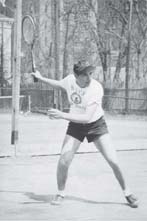
The captain of the Boys High tennis team plays on one of Brooklyn’s many courts in the late 1930s. Courtesy of Ian Grad
“I went to Boys High. I was half a block from the trolley car that ran up Nostrand Avenue and took me there for a nickel. In ten minutes I’d be at school. In nice weather, I’d walk home.
“I started high school in 1939. Boys High was in Bedford-Stuyvesant, a black neighborhood, so they had some black kids. We had a mix of kids from other Brooklyn neighborhoods, and for the most part everyone got along. I do recall one time Donnie Workman, a fierce fighter from our neighborhood who went to school with me, got in a fight with a black kid who was much bigger than him, and Donnie beat the crap out of him, so this guy pulled a knife and slashed Donnie’s coat. But I never had any problem with anybody in the school. I was an academic and an athlete.
“Boys High was a very high-level academic school. Norman Mailer graduated from there the year before I started. I never knew about him until he wrote The Naked and the Dead, and I read it. The great jazz drummer Max Roach was in the class ahead of me. It was the high school equivalent of what City College was in those days, a school with a very high academic standing. And I got a better education than if I had gone to a coed school like Erasmus, because I didn’t have any distractions with girls.
“I was the captain of the tennis team there. There were a lot of tennis courts in Brooklyn back then. I used to belong to the Mammoth Tennis Club, which ran from New York Avenue to Albany Avenue and from Winthrop Street to Clarkson Avenue, opposite Kings County Hospital. Before the war, they had fifty courts and it only cost $15 a year to play there. After the war, they only had twenty-four courts. By the time I moved to Long Island, it was down to twelve courts, and it cost $100 a year to play. Eventually the land was used to build the Downstate Medical Center.
“My senior year I won the Rensselaer Medal for excellence in math and science. I was thinking of applying to Rensselaer Polytechnic Institute, so I asked my advisor, ‘Do you think I could get a merit scholarship there?’ He said, ‘Don’t waste your time. They will never give it to you because you’re Jewish.” He told me straight out.
“My father wanted me to become a dentist. I said to him, ‘I’m not standing, looking into open mouths all day and inhaling bad breath. No, that’s not for me.’ And I wasn’t going to be a pharmacist, because I saw the hell his life was. I knew I wouldn’t become a lawyer, from looking at other kids in my class who had the gift of gab. They could stand up and talk, and nothing bothered them. And I wasn’t interested in medicine. I wasn’t going to be a doctor, even though in all the middle-class Jewish families, a doctor was the big thing. Mothers always wanted their daughters to marry a doctor.
“I graduated from Boys High in January 1943. The war was still on. I was seventeen, and when I turned eighteen I would be subject to the draft. I had to make a decision. Should I go to college? Should I do something that would get me a better position in the service? I didn’t want to get sucked in as a draftee and become a regular foot soldier.
“We had a family friend, Al Rogers, who, when I was sixteen, gave me a summer job in his machine shop, making fifteen bucks a week. He was doing subcontracting work for the war effort, and I was learning how to use the equipment rather than doing much work. I decided to go to engineering school at Rensselaer even if I couldn’t get a scholarship. And I wasn’t awarded that scholarship. The first year my parents had to pay my room and board, which was $1,200 a year.
“In the meantime, I interviewed for the navy V-1 training program. The officer who interviewed me asked why I was interested in joining the program, but I didn’t give him the red-white-and-blue, patriotic, fight-for-your-country answer he was looking for.
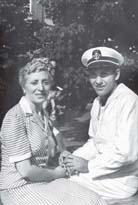
ROTC cadet Ian Grad and his mother. Courtesy of Ian Grad
“A smart man only makes a mistake once. After I entered RPI, I interviewed for its naval ROTC program. Two hundred students applied. Only twenty-five were accepted. This time I gave them a good story. I talked about how my father had been in the British merchant marine and how I wanted to carry on the family tradition, and me being technically oriented, this was the best way for me to serve my country.
“So they accepted me and another Jewish kid, Benjamin Ward. Neither of us had Jewish-sounding names. The other twenty-three were Christians.”
In July 1943, the ROTC at RPI was activated to full-time duty. The cadets wore uniforms, and the government paid them $25 a month. In July 1944, Grad and his fellow cadets were assigned to a Canadian corvette, and in convoy they went to the Guantanamo, Cuba, naval base. In danger of being sunk by U-boats lurking along the East Coast, they fired ash-can depth charges off the back of the ship.
On the way back they were caught up in a fierce hurricane near Cape Hatteras. During the hurricane, Grad had duty in the crow’s nest, watching for the enemy. As the ship bobbed around like a cork in the middle of nowhere, Grad, dressed in his slicker, couldn’t see a foot in front of him.
“This was the first leg of my nonwar experience,” he said.
In July 1945, he was assigned to a minesweeper guarding New York Harbor. He was nineteen, and the highlight of the tour was a night of liberty in Times Square, going to a dime-a-dance parlor. The war ended before he graduated.
In the summer of 1946, Grad was transferred to an Italian ocean liner that had been captured in the port of Cristóbal on the Atlantic side of the Panama Canal. The ship, the SS Conte Biancamano, was stripped down and refitted into a troop ship, the USS Hermitage, that could transport seven thousand men. Grad sailed to Guam to fetch a load of troops waiting to come home. After the return, he was transferred to a ship that was scheduled to sail to the Bikini Atoll to observe the testing of the hydrogen bomb. Several days before he was due to sail, Grad got orders to go back to New York, where he was discharged.
“As Rocky Graziano, one of my neighbors, used to say, ‘Somebody up there likes me,’” says Grad.
Still only twenty, Grad returned to Brooklyn to live with his parents in Flatbush. In 1941, before he left for college, they had moved into a brand-new apartment on Hawthorne Street between Rogers and Bedford Avenues. As his mother, Anna, said, it was easier to move than get the apartment painted. Soon after returning, Grad sought to turn his engineering degree into a paying job.
New York City during the summers could be unbearable with the combination of fetid heat off the sidewalks and high humidity. Without air-conditioning, Brooklynites would sleep on the rooftops and fire escapes, and even on park benches. Brooklyn’s Jews fled their apartments to the Catskills and Poconos. With the end of the war, relief from the heat was on the way across America in the form of air-conditioning. The innovation would transform America. Ian Grad would be part of the transformation.
IAN GRAD “I wanted to go into the air-conditioning business. Before the war, the only buildings that were air-conditioned were movie theaters and the textile mills of South Carolina. That’s where Willis Carrier got his start: in the textile mills, to climate-control the yarn so it didn’t stretch.”
In 1946, Grad landed a job in a contracting firm that required him to go to the Carrier Engineering School in Syracuse for six weeks. While training there, his class was actually taught one day by Willis Carrier, the founder of the Carrier company and the man credited with inventing air-conditioning.
IAN GRAD “I finished the course, came back to Brooklyn, and I worked in the office designing air-conditioning systems for banks, retail stores, drugstores, and shoe stores. I did the Brooks Brothers store on Madison Avenue and 44th Street—my duct work still runs down the middle of the store today. I even did the nightclub of the Pierre Hotel, crawling around in the ceilings to see where we could run ducts. One time I saw Peter Lawford standing out front waiting for a cab.”
For his next job he designed air-conditioning systems for many of the Broadway theaters along 45th and 46th Streets. While he was installing the system for the Bijou movie theater, he saw The Red Shoes six times.
Ian Grad had accumulated enough money with his parents to buy a house in what was then considered “the country.” His father had been working in a pharmacy on Avenue P in Brooklyn, and then after the war he bought a pharmacy on Woodhaven Boulevard in Rego Park, Queens, with his business partner Nat Kupor. In 1954 they bought a second one in Lindenhurst on Long Island.
IAN GRAD “We bought a house in Seaford, Long Island, in 1954. When I was working for Thermodyne Air Conditioning in the late ’40s, I had said to the chief engineer, ‘Where do you live?’
“He said, ‘Massapequa, out on Long Island.’
“I said, ‘Where the hell is that? I never heard of it.’ I went to look on a map, and I thought, This guy has got to be nuts. He travels all the way from there to get into the city?
“Eight years later I was living in the next town.”
Moving to the suburbs wasn’t all it was cracked up to be.
IAN GRAD “The first day was kind of horrendous. We get there, and the contractor who built the house had never cleaned his construction stuff from the garage. So the house was not really in move-in condition. And the first night we were living there, there was a huge rainstorm—a hurricane. I got up the next morning, and went down to the ground level—it was a split-level house—and the whole thing had two or three inches of water all over the floor. The wind had driven the rain through the foundation wall, which wasn’t properly waterproofed. I grabbed every towel we had to try to soak up all the water. And the first thing that went through my mind was, ‘What kind of a mess did we get ourselves into?’
“Our house was not the only one this had happened to. It was a totally new development, with all new houses. Eventually the contractor came around and sprayed waterproofing on the outside of the house. It never happened again, but that was some introduction to the suburbs, after having lived in an apartment building on an upper floor my entire life. This was quite an experience. Fortunately, since we had just moved in, there wasn’t any furniture in the room.
“Before we moved, when I was working in Long Island City in the Paragon Oil Building, I would drive up past the Brooklyn Navy Yard, and park on the street. It took me about thirty, forty-five minutes door-to-door. When I moved to the suburbs, I first had to drive to the Long Island Rail Road station, which was about two miles away. I would pick up one of my coworkers, who lived in another development in Seaford, on the way to the station. We would take the railroad to Hunters Point, which was right across the street from the building where we were working. It was an hour and twenty minutes door-to-door, and we had to change trains at Jamaica.
“So here we were, in a house, and we had to do all this stuff we never had to do before—like landscaping. Every two minutes I was running to the hardware store to buy all kinds of tools, which I still have today. There were salesmen coming around to sell us things—plantings, shades, blinds, trees, etc. A lot of it seemed like a big scam. We really had to learn all about which nurseries to go to, which catalogs to order seeds from. We had to plant in the front, in the back, shrubbery around the house, add a fence to separate our property from our neighbors’. Money was flying out of the house—we were constantly spending on all of this.
“We bought the house because my father and Nat had bought a store in Lindenhurst and he would run that one, and Nat would run the store in Rego Park. Unfortunately, the Lindenhurst store was not successful, and after a couple of years they wound up selling it.
“My mother wasn’t working at the time, so she stayed home and became the gardener. She seemed to enjoy it. In the back we planted tomatoes and strawberries, and indoor plants like begonias. We all kind of got into this horticultural mode when we got out there.
“We’d make the rounds of the local nurseries. We’d pick out something and take it home. We had all these books about how to plant properly. I remember planting a blue spruce tree—maybe it was about three feet tall. It had a big root ball with earth packed in it, and it was heavy as anything. I really hurt my back handling that tree. I went back around thirty years after I had lived there, to see the house, and that little tree had grown taller than the roof!
“I also did a lot of work around the house, fixing things up. The ground floor rec room was always cold, because the floor was just a concrete slab. I put in an insulated wood floor, laying down sleepers, and of course that concrete slab wasn’t level. What a job to get that right. And then I laid a plywood floor with vinyl asbestos tile on top of it! Let me tell you, it was no fun working on your hands and knees like that. We really could have used a Home Depot back then—we had to run around to a million different stores.
“In 1957, I got a job up in Hartford, Connecticut, but when the company opened a Manhattan office, I moved back to Long Island. Now I was commuting into Penn Station. It was still about an hour and twenty minutes, though. That year I met my wife, who was living in Kew Gardens Hills in Queens. We got married in November 1958, and moved to Forest Hills. Now I only had a half-hour subway ride to Manhattan. The next year, my parents sold the house and moved to Rego Park.
“All in all, living in the suburbs was interesting in the beginning, because I was a handy guy, and I got to do all these things that I had never done before. But after a while, it all got to be a drag, and the commute was awful. On my way home, the train was a local, and it stopped at every town on the South Shore. By the time I got home, I was beat. Also, as a single guy, I kind of felt like a fish out of water. Everyone out there was married and had kids already.”
After Grad left behind family members in Brooklyn, black families moved into their neighborhood, and his uncles and cousins witnessed the very beginnings of the “white flight” that began in earnest in the late 1950s.
IAN GRAD “When I was going to high school, the black population lived on the north side of Fulton Street. And as all the white middle class moved out to the suburbs, the blacks were becoming more affluent, and now they had someplace to move to. Brooklyn today has a large black population.”

Ian Grad and Janice Schapiro, the summer before they married. Courtesy of Ian Grad
After Ian Grad married Janice Schapiro (who grew up in East New York and Brighton Beach), and moved to Forest Hills, they raised their family. Their son Doug is the editor of this book. Henry Grad eventually retired to Margate, Florida. In 1979 he returned to college to take an organic chemistry course to get his Florida state pharmacy license so that he could do a little part-time work now and then, becoming, at eighty, the oldest college student in the state. He passed, of course. Henry lived there until 1987, when he died at age eighty-eight.
Ian Grad still lives in Forest Hills. Over the course of a nearly sixty-year career as an engineer, he was the project designer and manager for mechanical engineering work at the Jacob Javits Convention Center in Manhattan, the National Gallery of Art East Building in Washington, DC, and the Boston Museum of Fine Arts—all designed by architect I. M. Pei, as well as the United Airlines Terminal at O’Hare Airport in Chicago. He also designed the original air-conditioning system for the Museum of Modern Art in the 1950s, was the mechanical engineering consultant at Trump Tower for ten years, and was involved in the construction phase of the Ellis Island Immigration Museum.
Doug Grad got married in 1995, and a year later, he and his wife, Kim, announced that they were going to move from their one-bedroom rental apartment in Forest Hills and buy a co-op apartment in Brooklyn. When he heard that, Ian couldn’t believe it. “You’re moving where?” he said. “To Brooklyn? Why? We left there!” The last time he’d been to Brooklyn was in 1980, when he saw sad and depressing sights—graffiti, garbage on the streets, drug dealers—a far cry from what he’d remembered. But a lot had changed in the ensuing sixteen years, and Doug, whose Brooklyn roots run deep, returned to the ancestral home in 1996. Doug and Kim and their two kids—the fourth generation of Grads to live in Brooklyn—live in Park Slope.
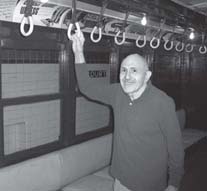
Ian Grad today, re-creating his years as a straphanger at the Transit Museum. Courtesy of Doug Grad